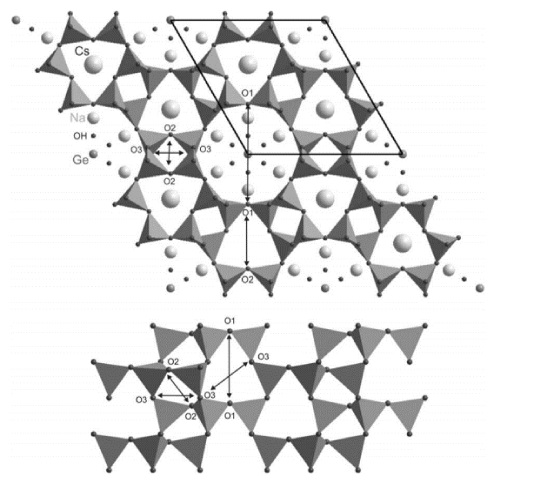The elastic behaviour and the pressure (P) induced structural evolution of Na6Cs2Ga6Ge6O24 · Ge(OH)6, a synthetic compound isotypic with cancrinite (CAN topology), have been investigated up to 5.01(5) GPa by means of in situ X-ray synchrotron powder diffraction with a diamond anvil cell and using a nominally penetrating hydrous P-transmitting medium (methanol:ethanol:water = 16:3:1). No evidence of phase-transition was observed within the P-range investigated. The P–V data were fitted with a Murnaghan equation-of-state (M-EoS). The elastic parameters obtained, using the data weighted by the uncertainties in P–V, are: V0 = 757.16(7) Å3, KT0 = 36(2) GPa [KT0 = 1/β = −V0(∂P/∂V)P=0, where β is the volume compressibility coefficient] and K′ = (∂KT0/∂P) = 9(1). The elastic behaviour along the a and c axis was described with a “linearised” M-EoS. The refined parameters of the linearised M-EoS are: a0 = 13.0314(4) Å, KT0(a) = 40(2) [βj = −1/(3KT0(j)) = (1/l0j)(∂lj/∂P), where βj is the axial compressibility coefficient] and K′(a) = 11(1) for the a-axis; c0 = 5.1485(4) Å, KT0(c) = 31(1) GPa and K′(c) = 7.4(8) for the c-axis. The elastic anisotropy of Na6Cs2Ga6Ge6O24 · Ge(OH)6 is only marginal, being KT0(a): KT0(c) = 1.29:1. The configuration of the extra-framework content is basically maintained at high-pressure, without any major changes. The Ge(OH)6-polyhedron is strongly compressed in response to the applied pressure, but there is no evidence of further deformation. On the other hand the Na(O3OH3)-polyhedron and the large Cs-polyhedron appear to be compressed in a way to lessen the deformation with increasing pressures. Despite the use of a hydrous P-transmitting fluid for the HP-experiment and the large “free-diameters” of the channels in CAN framework, no evidence of superhydration effect was observed within the P-range investigated.












